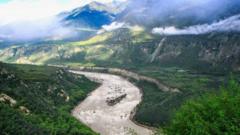The proposed Yarlung Tsangpo dam could displace communities and impact neighboring countries, raising alarms among rights advocates.
**China Launches Ambitious Yarlung Tsangpo Hydropower Dam Project, Faces Backlash**

**China Launches Ambitious Yarlung Tsangpo Hydropower Dam Project, Faces Backlash**
China's plan for the world's largest hydroelectric dam in Tibet prompts human rights concerns and environmental fears.
China has set in motion plans to construct the Yarlung Tsangpo hydroelectric dam, which is projected to be the largest of its kind globally. This move, while touted by Chinese officials as an eco-friendly venture aimed at bolstering local economies and supporting national climate objectives, has sparked extensive concerns regarding its implications for local communities and environmental integrity.
The dam, positioned along the Yarlung Tsangpo river's lower reach, is expected to produce thrice the energy output of the current record-holder, the Three Gorges Dam. Officials claim the project prioritizes ecological protection, countering the unease surrounding potential community displacement and disruption to ecosystems renowned for their biodiversity on the Tibetan Plateau.
Rights organizations worry that the dam's construction threatens to displace numerous local residents and fundamentally alter the natural landscape. Many activists argue that the project demonstrates a pattern of exploitation of Tibetan land by the Chinese government, especially in light of the region's tumultuous history since the annexation in the 1950s. Recent protests against a different dam project led to heavy-handed government crackdowns, raising alarms about ongoing human rights violations.
Although the Chinese government claims that it compensates and relocates affected locals, they have yet to disclose the expected number of displaced individuals for the Yarlung Tsangpo undertaking. The Three Gorges Dam previously necessitated the resettlement of about 1.4 million people. Additionally, the vast infrastructure required for the dam, including extensive tunneling through mountainous terrain, raises serious questions about its environmental safety, particularly in a zone prone to seismic activity.
Strategically, control over the water flow of the Yarlung Tsangpo, which traverses into India and Bangladesh, poses additional geopolitical tensions. Concerns have been expressed by experts that China’s control over these river systems could significantly impact the economies of neighboring countries, especially India, which is exploring similar hydropower initiatives as countermeasures.
The ambitious Yarlung Tsangpo project—projected to cost around 1 trillion yuan (approximately $127 billion)—highlights both the potential for renewable energy in China and the rising local and international fears surrounding environmental degradation and human rights.
As communities and environmentalists brace for the challenges ahead, the ramifications of this massive dam will reverberate far beyond China, impacting ecological systems and human lives across borders.
The dam, positioned along the Yarlung Tsangpo river's lower reach, is expected to produce thrice the energy output of the current record-holder, the Three Gorges Dam. Officials claim the project prioritizes ecological protection, countering the unease surrounding potential community displacement and disruption to ecosystems renowned for their biodiversity on the Tibetan Plateau.
Rights organizations worry that the dam's construction threatens to displace numerous local residents and fundamentally alter the natural landscape. Many activists argue that the project demonstrates a pattern of exploitation of Tibetan land by the Chinese government, especially in light of the region's tumultuous history since the annexation in the 1950s. Recent protests against a different dam project led to heavy-handed government crackdowns, raising alarms about ongoing human rights violations.
Although the Chinese government claims that it compensates and relocates affected locals, they have yet to disclose the expected number of displaced individuals for the Yarlung Tsangpo undertaking. The Three Gorges Dam previously necessitated the resettlement of about 1.4 million people. Additionally, the vast infrastructure required for the dam, including extensive tunneling through mountainous terrain, raises serious questions about its environmental safety, particularly in a zone prone to seismic activity.
Strategically, control over the water flow of the Yarlung Tsangpo, which traverses into India and Bangladesh, poses additional geopolitical tensions. Concerns have been expressed by experts that China’s control over these river systems could significantly impact the economies of neighboring countries, especially India, which is exploring similar hydropower initiatives as countermeasures.
The ambitious Yarlung Tsangpo project—projected to cost around 1 trillion yuan (approximately $127 billion)—highlights both the potential for renewable energy in China and the rising local and international fears surrounding environmental degradation and human rights.
As communities and environmentalists brace for the challenges ahead, the ramifications of this massive dam will reverberate far beyond China, impacting ecological systems and human lives across borders.



















